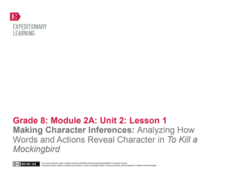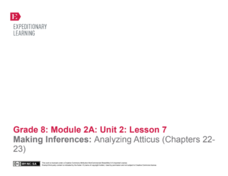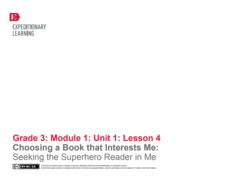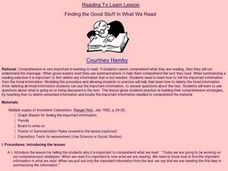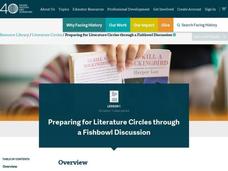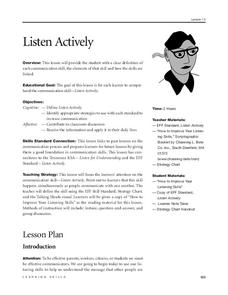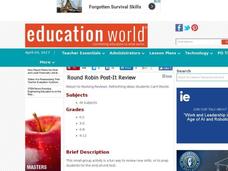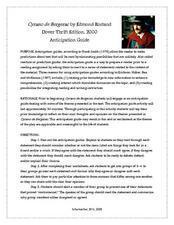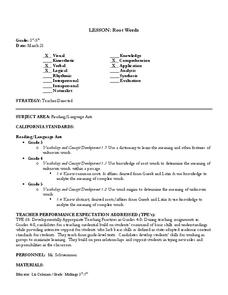EngageNY
Making Character Inferences: Analyzing How Words and Actions Reveal Character in To Kill a Mockingbird
Partner up! After an I have/who has activity, readers partner with one of their discussion appointments to add evidence from chapters 11-13 in To Kill a Mockingbird to the Atticus Note-catcher. Partners then share with the class and add...
EngageNY
Making Inferences: Analyzing Atticus (Chapters 22- 23)
What's the verdict? Scholars look closely at the reactions of various characters in To Kill A Mockingbird in the aftermath of the verdict. They circulate the room, responding to a variety of probing questions. Pupils finalize their...
EngageNY
End of Unit Assessment: Making Connections between Song Lyrics and Texts
For the end-of-unit assessment, scholars engage in small group Socratic seminars to connect the lyrics of two songs to texts they read and studied. They discuss how the songs "Ain't Gonna Let Nobody Turn Me Around" and "Lift Every Voice...
Curated OER
Tomas and the Library Lady
Learners practice read aloud comprehension strategies. In this literacy comprehension lesson, students listen to Tomas and the Library Lady, stopping to discuss with a partner aspects of the story suggested by the teacher. Learners make...
Curated OER
Literature-Based Skill Building: Freak the Mighty By Rodman Philbrick
Students complete a variety of comprehension activities related to the novel "Freak the Mighty" by Rodman Philbrick. They complete a learning log for each chapter, examine the purpose of signal words "because" and "but," define key...
Illinois State Board of Education
Common Core Teaching and Learning Strategies
Here's a resource that deserves a place in your curriculum library, whether or not your school has adopted the Common Core. Designed for middle and high school language arts classes, the packet is packed with teaching tips, materials,...
EngageNY
Choosing a Book That Interests Me: Seeking the Superhero Reader in Me
Selecting a "power book" and engaging in a structured class discussion are the learning targets for this fourth instructional activity in a larger unit. It is designed as a beginning of the year unit for establishing norms and routines...
Visa
Using Credit Wisely
Receiving credit can be both a benefit and a curse. Prepare your learners to make wise credit choices by studying how credit influences credit scores, identifying the different components of credit cards, and exploring major consumer...
Curated OER
Do You Know What You Just Read?
Students answer reading comprehension questions using the "story grammar" technique. They listen to a story and then answer questions using the technique: main character, setting, main events, and resolution. Students complete an...
Curated OER
Letter Recognition: Confusable Letter Pairs
Young scholars distinguish between easily-confused letter pairs such as b and d, p and b, m and w, and n and m. They read and listen to a story that highlights words containing the letter pairs. They use picture clues to aid reading...
Curated OER
Finding the Good Stuff in What We Read
Students work to develop comprehension strategies. They focus on three rules for summarizing: getting rid of extra information, organizing, and finding the main idea. Through modeling and then guided practice, they apply these rules ...
Curated OER
Jojo's Story
Students explore global relationships by reading stories of children in villages. In this foreign aide lesson, students discuss the story Jojo's Story which describes the trials and tribulations of a ten year old boy living in a natural...
Facing History and Ourselves
Literature Circles: Preparing for Literature Circles through a Fishbowl Discussion
Young scholars examine the attributes of productive conversations. For this fishbowl discussion lesson, students observe a modeled discussion of a literature circle. Young scholars watch a discussion of "The Bear That Wasn't" and note...
Curated OER
The Interactive Read-Aloud
Students discover the joy of reading a book through the teaching method of a read-aloud while interacting with the teacher by answering different questions. The lesson includes a sample of a read-aloud and the dialogue used with students...
Curated OER
We Can Eat Smarter
Students practice their reading skills. In this reading comprehension lesson, students read an article titled "We Can Eat Smarter," and then use the reading strategy described to note confusing passages and revisit them.
University of Tennessee
Listen Actively
Listening is a skill, and with the help of the communication activities in this packet, class members improve their active listening skills.
Curated OER
Round Robin Post-It Review
Learners of all ages participate in a unique review activity. They work in a small group setting on individual review questions designed by the teacher. Each individual answers a key review question on a notecard or sticky note and...
Curated OER
Cyrano do Bergerac Anticipation Guide
Introduce Cyrano de Bergerac with an anticipation guide that asks class members to rate a series of qualities that they look for in a friend. Groups then share their responses and present the class with the quality that provided the most...
Haut Gap Middle School
Root Words
Scholars demonstrate their knowledge of root words aqua and aud, and develop vocabulary skills by completing of a chart, handout, and worksheet using creative thinking skills, a dictionary, and a thesaurus.
Curated OER
Identifying Features of Nonfiction Text
Learners explore nonfiction text. They identify the cover, title page, and table of contents of a nonfiction book. Pupils work in groups to create a chapter for a nonfiction class book about heroes.
Curated OER
Reading Fiction - Character
The goal of this lesson is to have learners understand how character is created through a combination of what they say and do, and what others say about them. In pairs, learners construct a short dialogue between a parent and child after...
Curated OER
Woody Guthrie: Life and Art
Woody Guthrie will capture the imagination of even your most reluctant learners. Using his work, your class will develop their skills in non-fiction reading comprehension, interpreting primary source material, and use of multiple forms...
Brigham Young University
Bloom’s Taxonomy: Questions for Harry Potter and the Chamber of Secrets
As part of their study of Harry Potter and the Chamber of Secrets, readers respond to a series of questions based on chapter eight of J.K. Rowling's second novel in the series about the famous young wizard.
Curated OER
Get ready, get set? READ!!!
Students participate in reading exercises to improve speed, fluency, and comprehension. As a class, students practice reading skills to increase their speed and comprehension. Partners take turns competing in a reading race while reading...
